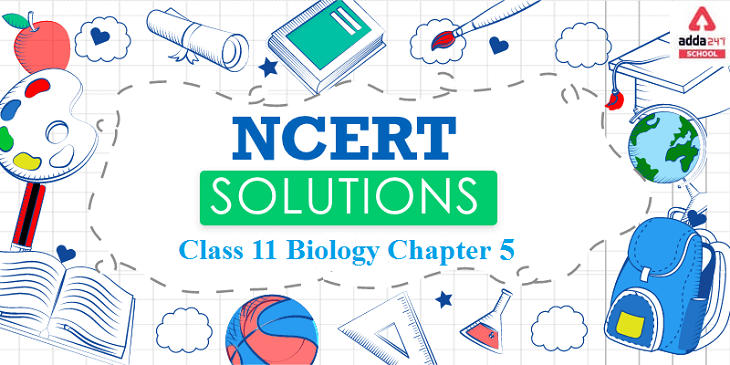Ncert Solutions For Class 11 Biology Chapter 5 English Solution
Adda 247 provides NCERT Solutions for Class 11 Biology Chapter 5 which is for the students who want to go ahead in life and achieve great marks in their examinations. The NCERT Solutions for class 11 Biology Chapter 5 are provided by the teachers who are experts of their subjects. The solutions are set according to the rules formulated by the NCERT and in the language that can be understood by every student. By these reading the solutions students can build up a strong base easily. The NCERT class 11 Biology solutions covers the chapters 1 to 22 with the important questions and the answers in a detailed way.
Examinations can be threatening for some people, a proper learning of the concepts is the key to crack the examination. Students rely on Ncert Solutions for class 11 Biology Chapter 5 provided by Adda 247. The solutions are formulated by the experts of the subjects who have tremendous knowledge in their subjects.
These NCERT Solutions help the students to get familiarized with the textbooks. The students can access the solutions anywhere while browsing the web easily. The solutions are very precise and accurate.
NCERT Solutions for Class 11 Biology Chapter 5 – Morphology of flowering plants
Ncert Solutions for class 11 Biology Chapter 5 provides information about Morphology of flowering plants. Morphology of Flowering Plants Class 11 Ncert Solutions talks about flowering plants. Also, it explains that there is a wide variation in the shape, size, and mode of nutrition, habit and habitat, and life span of flowering plants. Furthermore, they have a well-developed shoot and root system. Moreover, it explains the various that dicotyledonous plants have taproots and monocotyledons have fibrous roots. In addition, the root system of some plants modifies for storage of food, mechanical support, and various other processes. Besides, stem, flowers, leaves, and fruits are the different parts of the shoot system.
Most noteworthy, the morphological features of the stem help to differentiate the stem from roots. Apart from that, the stem modifies and perform diverse functions. Moreover, leaves also exhibit marked variations and get modified into other structures like tendrils. Furthermore, the flower is meant for sexual reproduction and they are arranged into different types of inflorescences. In addition, they show a huge variation in structure, the position of the ovary, symmetry and much more. Besides, the floral diagram represents the floral features of a flower.
[sso_enhancement_lead_form_manual title=”Download Full PDF of Class 11 Biology Chapter 5 ” button =”Download Now” pdf =”/jobs/wp-content/uploads/2021/06/11122147/English-chapter-5.pdf”]
Key Features of the NCERT Solutions for Class 11 Biology Chapter 5 – Morphology of flowering plants
Ncert Solutions for Class 11 Biology Chapter 5 have been answered based on the important information on the question.
- The columns are used wherever necessary.
- Solutions are solved point-wise and accurately answered point to point.
NCERT Solutions for Class 11 Biology Chapter 5: Important Question
Question 1. What is meant by modification of root? What type of modification of
root is found in the:
(a) Banyan tree (b) Turnip (c) Mangrove trees
Answer: Two types of root systems are present in the plants namely, tap root system and fibrous root system. The function of the roots is to absorb water and minerals from the soil and transport it to plants. The roots can be modified to perform different functions in the plants. They act as sites of storage, providing support to the massive plant structures, while some absorb oxygen from the atmosphere.
The root modification in the following plants:
(a) Banyan tree
Ficus benghalensis display a massive pillar like adventitious roots arising from the aerial part of the stem. The roots grow towards the ground and provide support to the tree. These modified roots are prop roots.
(b) Turnip
Brassica rape helps in the storage of food. The food storing roots are present in radishes, carrots and sweet potatoes.
(c) Mangrove tree
The roots of the mangrove tree grow vertically towards upwards from the soil for the absorption of oxygen from the atmosphere as the soil is poorly aerated. These roots are known as pneumatophores.
Question 2. Justify the following statements on the basis of external features:
(i) Underground parts of a plant are not always roots. (ii) The flower is a modified shoot.
Answer:
(i) The various parts of the plants are modified into underground structures to perform the different functions of stems, leaves and fruits. In ginger and banana, the roots are underground and swollen because of the storage of food. These modifications are called as rhizomes. Corm is an underground stem in Colocasia and Zamin-khand. The tips of the underground stem in potato becomes swollen because of the accumulation of food and leads to the formation of a tuber. The tubers have eyes which are subtended by a leaf scar. The basal leaves of the onions become fleshy because of the accumulation of food.
(ii) During the flowering season, the apical meristem gives rise to the floral meristem. The axis of the stem is condensed while the internodes lie near each other. Instead of leaves, floral appendages arise from the node. It can deciphered that flower is a modified shoot.
Question 3. How is pinnately compound different from a palmately compound leaf?
Answer:
| Pinnately compound leaves | Palmately compound leaves |
| Various leaflets are present on the rachis (common axis) which is the midrib of the leaf. | The leaflets are present at a common point on the leaf stalk. |
| The outlines are like feathers. | It resembles palm of a hand. |
| Example: Neem | Example: Silk cotton |
Question 4. Explain with suitable examples the different types of phyllotaxy.
Answer: Phyllotaxy is the arrangement of leaves on the stem or branch of the plant. It is of three types:
(i) Alternate: A single leaf arises from the node of the branch which is observed in sunflower, mustard and peepal.
(ii) Opposite: Two leaves arise from a node in opposite directions which is observed in guava and jamun plants.
(iii) Whorled: Three or more leaves arise from node which is observed in Alstonia.
Question 5. Define the following terms:
(a) aestivation
(b) placentation
(c) actinomorphic
(d) zygomorphic
(e) superior ovary
(f) perigynous flower
(g) epipetalous stamen
Answer:
(a) Aestivation: It is mode in which sepals and petals are arranged in a floral bud with respect to other floral members. The four types of aestivation are valvate, twisted, imbricate and vexillary.
(b) Placentation: The arrangement of ovules within the ovary of a flower. It is of five types, marginal, basal, parietal, axile and free central.
(c) Actinomorphic: The flowers can be divided into two radial halves by any radial plane passing through its centre. Examples include chilly and mustard flowers.
(d) Zygomorphic: The flowers which can be divided into two same halves by a single vertical plane. Examples include pea and beans.
(e) Superior ovary: The gynoecium of the flower occupies the highest position while the other parts are present below it. It can be seen in mustard.
(f) Perigynous flower: The gynoecium is situated in the centre and other parts of the flower are present at the rim of the thalamus and at the same level. This is known as perigynous flower which is seen plum.
(g)Epipetalous flower: The flowers where stamens are attached to the petals in brinjals.
Question 8. Describe modifications of stem with suitable examples
Answer: Stems are modified to perform different functions. The underground stems are modified to store food in them. They act as organs of perennation to survive the conditions unfavourable for growth. The different modifications of stem are:
(a) Undergroundmodificationsarethestoragestems.Ingingerandbanana,theundergroundstems are known as rhizomes while in Colocasia, the stems are called as corm. Rhizomes and corms are modified for storage of food. They also help in vegetative reproduction. The underground stems in potato are swollen because of accumulation of food. The potato tuber helps in storage of food and bears eyes on it.
(b) Supportive stems such as tendril. The stems in weak plants have thin and slender, spirally coiled structures known as tendrils which help the plants to get attached to nearby structures for support. Tendrils are present in cucumbers, melons and other members of the family Cucurbitaceae.
(c) Protectivestemsincludethorns.ThestemsofBougainvilleaandcitrushavesharp,pointed structures known as the thorns which provide protection to the plants from animals.
(d) Photosynthetic stems which are green in colour. Examples, Opuntia.
(e) Other modifications include grass which is spread in the soil and help in perennation. This modification is runner.
Question 9. Take one flower each of the families Fabaceae and Solanaceae and write its semi-technical description. Also, draw their floral diagram after studying them.
Answer:
(1) Fabaceae (pea plant):
Fabaceae/ Papilionaceae is a sub family of Leguminoseae family.
Habit: Pinnately compound, alternately arranged with leaf tendrils with the pulvinus present at the leaf base along folacious stipules.
Root: Tap root system with root nodules.
Floral features-
Inflorescence: Racemose, generally axial than terminal
Flower: Zygomorphic and bisexual flowers
Calyx: It contains five sepals which are gamosepalous while aestivation is inbricate.
Corolla: It has five petals (polypetalous) with vexillary aestivation.
Androecium: It has ten anthers which are diadelphous with dithecous anthers. Gynoecium: Monocarpellary superior ovary with unilocular marginal placentation. Fruit: Legume pod with non-endospermic seeds.
Economic importance: They are used as vegetables for culinary preparations.
(2) Solanum nigrum
Vegetative features:
Habit: Erect, herbaceous plants
Leaves: Simple, exstipulate leaves with reticulate venation
Stem: Erect stem with various branches
Floral features:
Inflorescence: Solitary and axillary
Flowers: Actinomorphic, bisexual flowers
Calyx: It is composed of five sepals that are united and persistent. Aestivation is valvate. Corolla: It consists of five united petals with valvate aestivation.
Androecium: It has five epipetalous stamens.
Gynoecium: It has bicarpellary syncarpous superior ovary with axile placentation. Fruits: Berry seeds
Economic importance: Medicinal purpose
Question 10. Describe the various types of placentations found in flowering plants. Answer: Five types of placentation can be found in flowering plants:
(1) Axile placentation: The placentation is seen in bi-or multi-carpellary and syncarpous ovary. The walls of the carpels fuse in the middle of the ovary where the placenta is formed like a central column. The ovules are present towards the centre of the placenta in each locule. For example, in Hibiscus.
(2) Marginal placentation: The placentation is present in monocarpellary, unilocular ovary. The ovules are present along the junction of the two margins of the carpel. It is seen in family Fabaceae.
(3) Parietal placentation: The placentation is seen in multicarpellary, syncarpous, unilocular ovaries. The carpels are united by their margins. The placenta has ovules which develops at places where only two carpels are fused. It is seen in Cucumber.
(4) Basal placentation: The placentation is observed in bicarpellary syncarpous and unilocular ovaries. The placenta develops on the receptacle that has single ovule at the base of the ovary. It is seen in the family Asteraceae.
(5) Superficial placentation: The placentation occurs in multicarpellary, multilocular ovary. The ovules are present on the placentae which develops all-round the inner surface of the wall that develops a partition. It is seen in Nymphaeceae.
Question 11. What is a flower? Describe the parts of a typical angiosperm flower
Answer: Flower is a modified shoot. It is the reproductive unit of the plant. It serves as the organ of reproduction. The flower has four whorls arranged successively on the swollen end of the receptacle known as the thalamus. The parts of the flower are:
(i) Calyx: The outermost whorl of the flower is the calyx which possess sepals. The sepals are green, leaf like structures that cover and protect the flowers during the bud stage. When the sepals of the flowers are free, they are known as polysepalous, when fused they are known as gamosepalous.
(ii) Corolla: The layer inside the calyx is corolla. It possess petals which are brightly colours and help in attraction of the insects for pollination. Each of the anther is bilobed with each lobe having two chambers known as the pollen sacs. The pollen sacs have male gametes or pollen grains.
(iii) Androecium: The male reproductive part of the flower. It is composed of stamens. The stamen is a stalk or filament and an anther. Each anther has two lobes with each lobe having two chambers known as the pollen sacs. The pollen sacs have the male gamete or the pollen grains.
(iv) Gynoecium: It represents the female reproductive part of the flower. It is composed of carpels. A carpel is made up of three parts namely stigma, style and ovary. Ovary is the enlarged portion at the base. The ovary is connected by a long tube known as the style. The stigma is the sticky tip present at the end of the style. Ovary bears ovules attached to the placenta.
Question 12. How do the various leaf modifications help plants?
Answer: Leaf is a green, lateral and flattened growth which is borne on the node of a stem or its branches and is specialised to perform photosynthesis. The leaves often modify themselves to perform several other functions also. The modifications of leaves are:
- Tendrils: The tendrils help the plants in climbing.
- Spines: These are hard and stiff structures which act as organs of defence as seen in cactus.
- Phyllode: The leaves of the plants are short lived and soon replaced by flattened, green structures known as the phyllodes. They arise from petiole of the leaves and involved in synthesising food.
Pitcher: The leaves of the pitcher plant are modified into pitcher like structures. They have digestive juices which help in trapping and digesting insects.









 HPBOSE Compartment Date Sheet 2025 Out, ...
HPBOSE Compartment Date Sheet 2025 Out, ...
 RUHS Counselling 2025 Round 1 Seat Allot...
RUHS Counselling 2025 Round 1 Seat Allot...
 Bihar Board Dummy Registration Card 2026...
Bihar Board Dummy Registration Card 2026...










